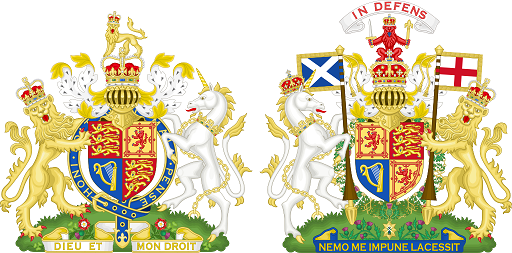The monarchy of the United Kingdom, commonly referred to as the British monarchy, is the constitutional form of government by which a hereditary sovereign reigns as the head of state of the United Kingdom, its dependencies (the Bailiwick of Guernsey, the Bailiwick of Jersey and the Isle of Man) and its overseas territories. The current monarch is Queen Elizabeth II, who ascended the throne in 1952.
The monarch and their immediate family undertake various official, ceremonial, diplomatic and representational duties. As the monarchy is constitutional, the monarch is limited to functions such as bestowing honours and appointing the prime minister, which are performed in a non-partisan manner. The monarch is also Head of the British Armed Forces. Though the ultimate executive authority over the government is still formally by and through the royal prerogative, these powers may only be used according to laws enacted in Parliament and, in practice, within the constraints of convention and precedent. The Government of the United Kingdom is known as Her (His) Majesty’s Government.
The British monarchy traces its origins from the petty kingdoms of early medieval Scotland and Anglo-Saxon England, which consolidated into the kingdoms of England and Scotland by the 10th century. England was conquered by the Normans in 1066, after which Wales also gradually came under control of Anglo-Normans. The process was completed in the 13th century when the Principality of Wales became a client state of the English kingdom. Meanwhile, Magna Carta began a process of reducing the English monarch’s political powers. From 1603, the English and Scottish kingdoms were ruled by a single sovereign. From 1649 to 1660, the tradition of monarchy was broken by the republican Commonwealth of England, which followed the Wars of the Three Kingdoms. The Act of Settlement 1701 excluded Roman Catholics and their spouses from succession to the English throne. In 1707, the kingdoms of England and Scotland were merged to create the Kingdom of Great Britain, and in 1801, the Kingdom of Ireland joined to create the United Kingdom of Great Britain and Ireland. The British monarch was the nominal head of the vast British Empire, which covered a quarter of the world’s land area at its greatest extent in 1921.
In the early 1920s the Balfour Declaration recognised the evolution of the Dominions of the Empire into separate, self-governing countries within a Commonwealth of Nations. In the years after the Second World War, the vast majority of British colonies and territories became independent, effectively bringing the Empire to an end. George VI and his successor, Elizabeth II, adopted the title Head of the Commonwealth as a symbol of the free association of its independent member states. The United Kingdom and fifteen other independent sovereign states that share the same person as their monarch are called Commonwealth realms. Although the monarch is shared, each country is sovereign and independent of the others, and the monarch has a different, specific, and official national title and style for each realm.







